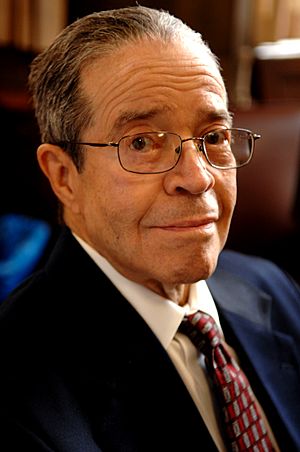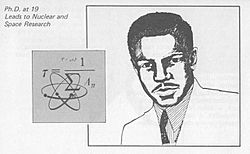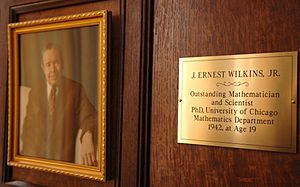J. Ernest Wilkins Jr. facts for kids
Quick facts for kids
J. Ernest Wilkins Jr.
|
|
|---|---|

Wilkins in 2007
|
|
| Born | November 27, 1923 Chicago, Illinois, U.S.
|
| Died | May 1, 2011 (aged 87) Fountain Hills, Arizona, U.S.
|
| Alma mater | University of Chicago |
| Known for | Work on nuclear physics and engineering |
| Scientific career | |
| Fields | Mathematics and physics |
| Institutions | Metallurgical Laboratory Argonne National Laboratory |
| Influences | J. Ernest Wilkins Sr. Arthur Holly Compton Enrico Fermi |
Jesse Ernest Wilkins Jr. (born November 27, 1923 – died May 1, 2011) was an amazing African American scientist. He was a nuclear scientist, an engineer, and a mathematician.
He was a child prodigy, which means he was super smart from a very young age. He started college at the University of Chicago when he was only 13 years old! This made him the youngest student ever at that university. When he graduated so young, people called him "the Negro Genius" in the news.
Wilkins worked with another scientist, Eugene Wigner. Together, they created a special method called the Wigner-Wilkins approach. This method helps figure out how energy from tiny particles called neutrons moves inside nuclear reactors. This is super important because it's how all nuclear reactors are designed today!
Wilkins had a long and varied career that lasted for 70 years. He made big contributions to many areas, including math, engineering, and optics (the study of light). He was also one of the African American scientists who worked on the Manhattan Project during World War II. This was a secret project to build the first atomic bomb.
Even though he was incredibly talented, Wilkins often faced racism during his life. He wrote many scientific papers, held important jobs, won awards, and helped encourage other minority students to study science.
Contents
Early Life and College
In 1940, Wilkins earned his first degree in mathematics from the University of Chicago. He then continued his studies there, getting his master's degree in 1941 and his PhD in mathematics in 1942. He was very young to have so many advanced degrees!
After finishing his studies, Wilkins taught mathematics for a short time. From 1943 to 1944, he taught at the Tuskegee Institute in Alabama.
Working on the Manhattan Project
In 1944, Wilkins returned to the University of Chicago. He joined the Metallurgical Laboratory, which was part of the top-secret Manhattan Project. He worked with famous scientists like Arthur Holly Compton and Enrico Fermi.
Wilkins researched how to get special nuclear materials that could be split apart. He didn't even know the real goal of the project until after the atomic bomb was used in Hiroshima. During this time, he helped discover important physics ideas like the Wilkins effect and the Wigner–Wilkins spectra.
There was a big problem when Wilkins's team was going to move to a new lab in Oak Ridge, Tennessee. Because of unfair Jim Crow laws in the Southern United States, Wilkins, as an African American, would not have been allowed to work there.
When another famous scientist, Edward Teller, heard about this, he wrote a letter. In his letter, Teller explained how talented Wilkins was and how unfair the situation was. He suggested that Wilkins should be given a new job where he wouldn't face such discrimination.
Knowing that men of high qualifications are scarce these days, I thought that it might be useful that I suggest a capable person for this job. Mr. Wilkins in Wigner's group at the Metallurgical Laboratory has been doing, according to Wigner, excellent work. He is a colored man and since Wigner's group is moving to "X" it is not possible for him to continue work with that group. I think that it might be a good idea to secure his services for our work.
After this, Wilkins continued to teach math and do important research with physicist Eugene Wigner. They worked on how neutrons are absorbed, creating special math models. Later, he also helped design and build nuclear reactors that create electricity. He even became part owner of a company that built them!
Later Career and Achievements
To help scientists and engineers work better together on projects, Wilkins decided to learn even more. He earned two more degrees in mechanical engineering from New York University, one in 1957 and another in 1960. This meant he had five science degrees in total! These new degrees also helped him design and build nuclear facilities.
In 1970, Wilkins became a special professor at Howard University. He also helped start the university's PhD program in mathematics. For a year, from 1976 to 1977, he was a visiting scientist at Argonne National Laboratory.
Wilkins was elected president of the American Nuclear Society from 1974 to 1975. In 1976, he became only the second African American person to be chosen for the National Academy of Engineering. This is a very high honor for engineers.
From 1990, Wilkins lived and worked in Atlanta, Georgia. He was a distinguished professor at Clark Atlanta University. He finally retired for the last time in 2003.
Throughout his many years of research, Wilkins wrote over 100 scientific papers. These papers covered many topics, including math, nuclear engineering, and optics. He received many professional and scientific awards for his amazing work.
Family Life
Wilkins married Gloria Louise Steward in 1947, and they had two children, a daughter named Sharon and a son named J. Ernest III. Gloria passed away in 1980. He later married Maxine G. Malone in 1984, and then Vera Wood Anderson in 2003.
His father, J. Ernest Wilkins Sr., was also a very important person. He served as the US Assistant Secretary of Labor during the time of President Eisenhower.
Wilkins passed away on May 1, 2011, in Fountain Hills, Arizona. He was buried at the National Memorial Cemetery of Arizona on May 5.
Honors and Recognition
- The Wilkins effect, and the Wigner–Wilkins and Wilkins spectra, are named after him. These were discovered in the 1940s.
- In March 2007, his old university, the University of Chicago, honored him. They put up his portrait and a special plaque in one of their buildings.
- He received the U.S. Army Outstanding Civilian Service Medal in 1980.
- He received the Giant in Science Award in 1994.
- The Department of Energy gave him a Special Recognition Award in 1996.
- The University of Chicago Alumni Association gave him a Professional Achievement Citation in 1997.
Memberships
Wilkins was a member of many important groups, including:
- Kappa Alpha Psi fraternity (from 1938)
- National Academy of Engineering (elected in 1976)
- American Society of Mechanical Engineers
- American Nuclear Society (President from 1974–75)
- National Research Council of the United States (Chairman of an advisory committee from 1990–94)
- U.S. Army Science Board (chairman from 1970–2001)
See also
- List of African-American inventors and scientists
- J. Ernest Wilkins Sr., Wilkins' father, who was the first African American to attend White House cabinet-level meetings.



